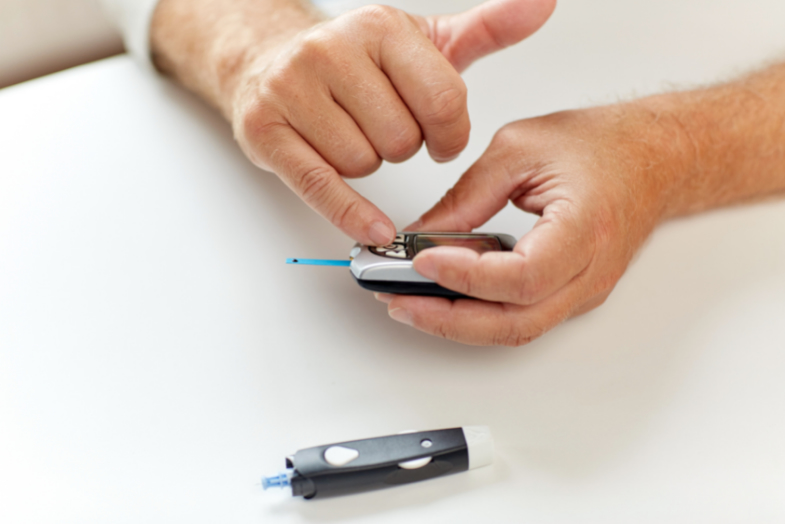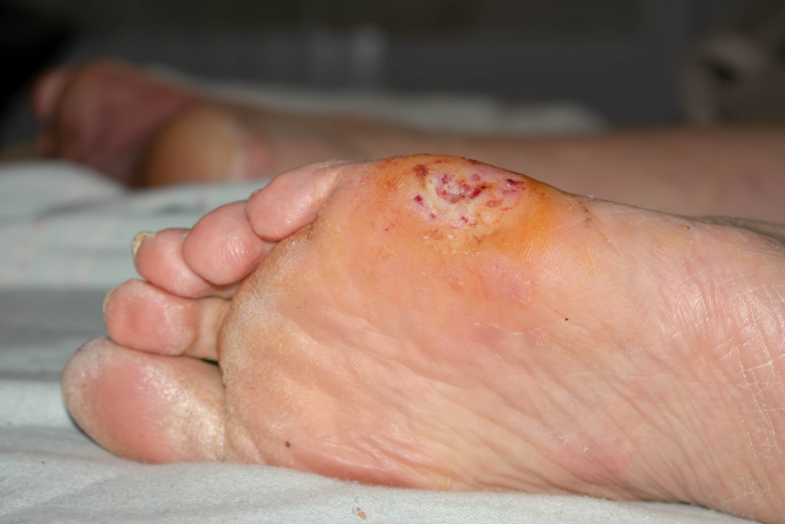Diabetic Foot Ulcer Stages
When you first begin treating diabetic foot ulcers, it’s important to know a little about the natural history of diabetic foot. Diabetic foot care at each stage requires multidisciplinary management. You can break down this condition into a series of five stages. Each has a unique physical appearance, symptoms, pain level, and potential treatment options. In this article, we’ll discuss the full spectrum of this foot disease, including the characteristics of early-stage diabetic foot ulcers, the following diabetic foot ulcer stages, and the foot ulcer treatment options that are possible for you at the different stages of this condition.
 What Is a Diabetic Foot Ulcer?
What Is a Diabetic Foot Ulcer?
A diabetic foot ulcer is a complication of diabetes, a condition in which the body doesn’t produce enough insulin nor respond to insulin properly. This improper response causes abnormally high blood sugar levels. Some of the common underlying causes of a diabetic foot ulcer are neuropathy, peripheral arterial disease, deformity, trauma, and high plantar pressures. However, a systematic and thorough evaluation of your foot ulcer can help guide treatment. Removal of damaged, dead, or infected tissue and management of underlying infections is critical to the care of foot ulcers and the prevention of an exacerbated condition.
Ulcers and other skin wounds, such as those found on the toes and feet, can become infected and take significant time to heal. People who have diabetes, as well as neuropathy, are most likely to develop these ulcers. They are sores or open wounds that struggle to heal and can recur. People with diabetes and neuropathy are the most likely to grow toe or foot ulcers as neuropathy causes a loss of feeling in the feet. A cut, puncture, or scrape on the skin can develop into an ulcer, but you may be less aware if you suffer from neuropathy. Roughly 15% of people with diabetes develop a toe or foot ulcer.
Diabetic Foot Ulcer Stages
Diabetic foot ulcers develop when the skin tissue of a foot breaks down, exposing the layers of skin underneath. When you don’t manage diabetes with exercise, diet, and insulin-based treatments, it can cause complications. One of the common complications is foot ulcers. Foot ulcers usually grow on the balls of the feet and under the big toes. Some even grow deep enough to expose the bone. These ulcers can become severely painful, and escalated cases may require amputation. The main diabetic foot ulcer stages are normal, high-risk, ulcerated, infected, and necrotic.
 Normal
Normal
In the early stages of a diabetic foot ulcer, you may experience irritated skin, foot odor, swelling, or redness. Early diabetic foot ulcers usually have no open lesions, or you may have a healed lesion. Signs of a foot ulcer may not be obvious yet. You may not present symptoms until your ulcer becomes infected. It’s important to prevent further growth of a foot ulcer in the early stages. A diabetic foot exam is one of the best methods of preventing more significant foot ulcers. With an exam, you can receive an effective evaluation of your condition. It’s also important to use proper footwear and consult your specialist about regular foot care habits.
High-Risk
In the next diabetic foot ulcer stage, you usually have a superficial ulcer. This ulcer hasn’t penetrated the deeper layers of the foot, such as the tendons, bones, or joints. However, at this second stage, the foot has one or more risk factors for more significant ulceration. These risk factors include ischemia, neuropathy, swelling, deformity, and calluses. You can accommodate the majority of deformities with special footwear. A callus is a significant precursor of an ulcer and should receive aggressive treatment, especially in a neuropathic foot. These superficial wounds are either through the epidermis or the dermis and epidermis.
Ulcerated
In the third foot ulcer stage, you have a deeper ulcer that reaches the tendon, joint capsule, or bone. In this stage, an ulcer may be in a neuropathic foot or a neuroischemic foot. With a neuropathic foot, the ulcer usually develops on the plantar surface of the toes and foot. These ulcers often have an association with high plantar pressures and neglected calluses. With a neuroischemic foot, the ulcer is usually near the edges of the foot, including the back of the heel and the apices. These ulcers often have an association with wearing unsuitable shoes or foot trauma. Stage 3 diabetic foot ulcers require pressure relief, sharp debridement, and dressings.
Infected
During the later diabetic foot ulcer stages, deeper tissues become involved and the foot wound becomes infected. To prevent a worsening condition such as this, make sure to examine your feet daily, practice proper foot hygiene, remove any excess debris from the area, and use medications. At this stage, microbiological control is essential, and severe infections may require intravenous antibacterial therapy. You should see a foot specialist to assess the need for debridement and surgical drainage. Without speedy treatment, your foot ulcer will continue to progress. Part of your bone may be visible and you may begin seeing signs of early gangrene.
Necrotic
In the last stage, necrosis sets into the area. You can divide necrosis into wet necrosis or dry necrosis. Neuropathic feet with wet necrosis require surgical debridement and intravenous antibacterials. Neuroischemic feet with wet necrosis may also require vascular reconstruction. Aggressive management can reduce the number of feet that grow infected and proceed to necrosis. This reduction then reduces the number of potential amputations. At this stage, there is extensive gangrenous involvement in the foot, and the entire foot may have gangrene. Seeing a podiatrist regularly and maintaining blood circulation can prevent this stage.
Treatment and Prevention of Diabetic Foot Ulcer Stages
When it comes to proper foot care and maintenance, there are some steps you can take to effectively prevent the diabetic foot ulcer stages. For the earliest possible foot ulcer treatment and prevention, take note of the symptoms and presentation of the diabetic foot ulcer stages and consult the Foot & Ankle Specialists of Illinois today.

